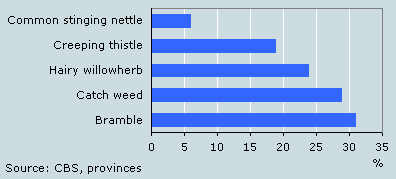More brambles and nettles in Dutch countryside

The quality of flora in the Dutch countryside deteriorated in the period 2000-2007. Vegetation such as brambles, catch weed, creeping thistles and stinging nettles have increased and displaced other plants.
Creeping thistle, bramble and stinging nettle now common
The prevalence of tall forbs, such as creeping thistle, catch weed, bramble and common nettle, is increasing. These species are occurring more and more in natural landscape elements, such as dikes and wooded banks, and in agricultural areas. In the period 2004-2007 the share of tall forbs in the countryside was 8 percent higher on average than in 2000-2003. Bramble blackberry showed the largest increase: 31 percent. Creeping thistle and common stinging nettle rose by 19 and 6 percent respectively.
Tall forbs are plants that grow quite high, and thrive on nitrogen-rich soil. One of their characteristics is that they displace other vegetation species. The increase in tall forbs is an indication that the quality of flora in the countryside is deteriorating.
Changes in tall forbs coverage in agricultural areas, 2000/2003 – 2004/2007

More tall forbs on dikes, wooded banks and ditches
Wooded banks, road verges dikes and ditches are important natural elements in the Dutch countryside. The increase in tall forbs is largest on the dikes, at 12 percent. On wooded banks the increase was 10 percent, and around ditches it was 8 percent.
Changes in tall forbs coverage by landscape element, 2000/2003 – 2004/2007

Isabel van Geloof (CBS) and Ate Dijkstra (Drenthe Province)